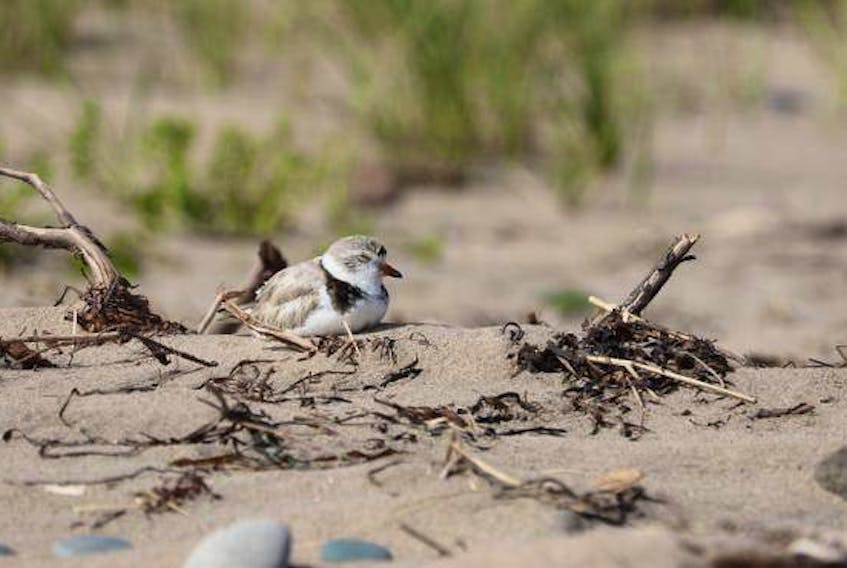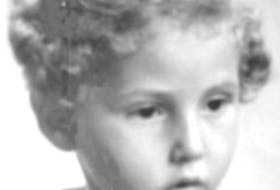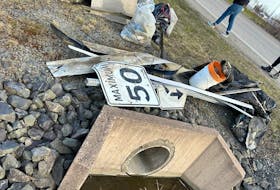Heed the signs and keep to the wet sand.
That’s the word from Bird Studies Canada as Nova Scotia’s dwindling piping plover population goes into a late nesting season.
This season has been harder than usual for the endangered shore bird, which usually lays its eggs near the end of April. Storms have caused washouts and relocations, which means that, in a lot of places, the eggs are just hatching.
“Some of them are still incubating. That’s late,” says Piping Plover Conservation Program co-ordinator Sue Abbott.
“We had a nest at Pomquet Beach and a couple of others in Pictou and Cape Breton that were washed out.’
That may not sound like a lot, but right now there are fewer than 50 breeding pairs in Nova Scotia, and fewer than 200 pairs overall in the Atlantic provinces.
“Our goal, according to the federal recovery strategy, is to have 310 breeding pairs in the Atlantic Region. So, we’re well short of that regional goal.”
This is Abbot’s 13th year monitoring and protecting piping plovers in Nova Scotia. Every year she and her team of staff and volunteers goes out to different beaches to identify those that have been chosen by plovers as nesting grounds.
“They’re excellent,” said Abbot about her team. “They’re so passionate. And it can be hard when they’re following a pair for months and the nest is so close to hatching, and then it disappears.”
The piping plover creates a very small nest in dry sand between the high-water line and the dense grass on dunes. The nest leaves only a small impression in the sand and is nearly impossible to see unless you know what you’re looking for.
On popular beaches, Abbot’s team ropes off these nesting sites to alert people, and signs are posted with instructions not to disturb these fragile birds or their habitat.
“They’re like little ghosts on the beach. They’re so hard to see and, more often than not, people don’t even realize that they’re around,” said Abbot.
“I’m happy to say that we rarely see people walking into fenced areas. The vast majority of beach-goers are doing the right thing, and respecting the signs. They’re really supportive.”
Pomquet Beach in Antigonish County has had fenced off areas for more than 10 years now. One of the nests this year has hatched three healthy chicks.
“They hatched either on the night of the 10th or on the 11th early in the morning,” said Ryan Allen, who is the Nova Scotia Lifeguard Service beach captain at Pomquet Beach.
“The babies are really fun to watch. They’re like little cotton balls with long legs.”
On July 12 Pomquet Beach was battered by high winds and waves that pushed the water-line right up to their protected area.
The following day there wasn’t any sign of the parents or the chicks, and there was some concern that the storm had once again washed out their nest. But, it’s not uncommon for families to relocate after the chicks are born and the family has since been spotted.
The piping plover, so called for it’s distinctively soft two-toned whistle, was once a common sight on Nova Scotia’s beaches, and along the Great Lakes of Ontario. Shore development causing habitat loss and other human activity has been the leading cause for their decline, but predators such as crows and foxes are still a danger. Combined with the increasingly unpredictable weather, conservation has been an uphill battle.
“I live by cautious optimism,” said Abbott. “That’s what I live by with plovers. You have to be optimistic with a species at risk. You just have to be to do this work.”
Despite the challenges, 2018 has brought some signs of hope. Piping plovers are establishing themselves on the Great Lakes for the first time in a decade.
Closer to home, there is some good news from Dominion Beach in Cape Breton.
“There haven’t been nesting plovers there since the early 90s, and a local woman found birds nesting there. And they’ve hatched.”
Bird Studies Canada is a long way off from their goal of having 310 nesting pairs of plovers in Atlantic Canada, but Abbott and her team’s hard work is paying off one nest at a time.
“We are doing everything we can within our means to give these birds a chance and to give them a safe space when they’re nesting here.”








